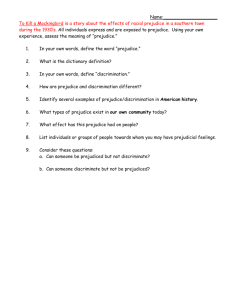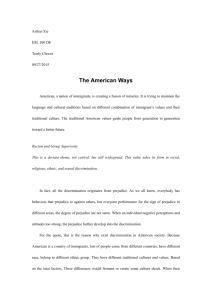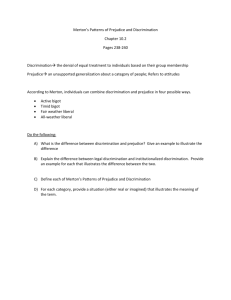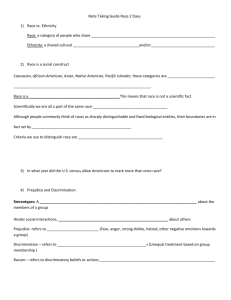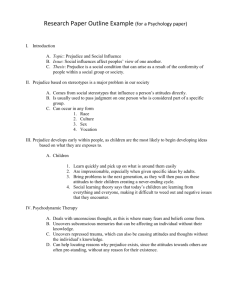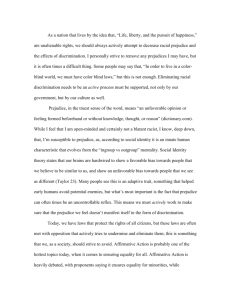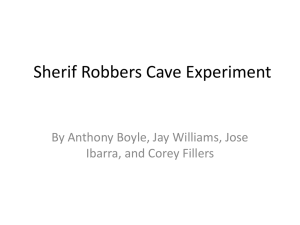Vineeth Alva
advertisement
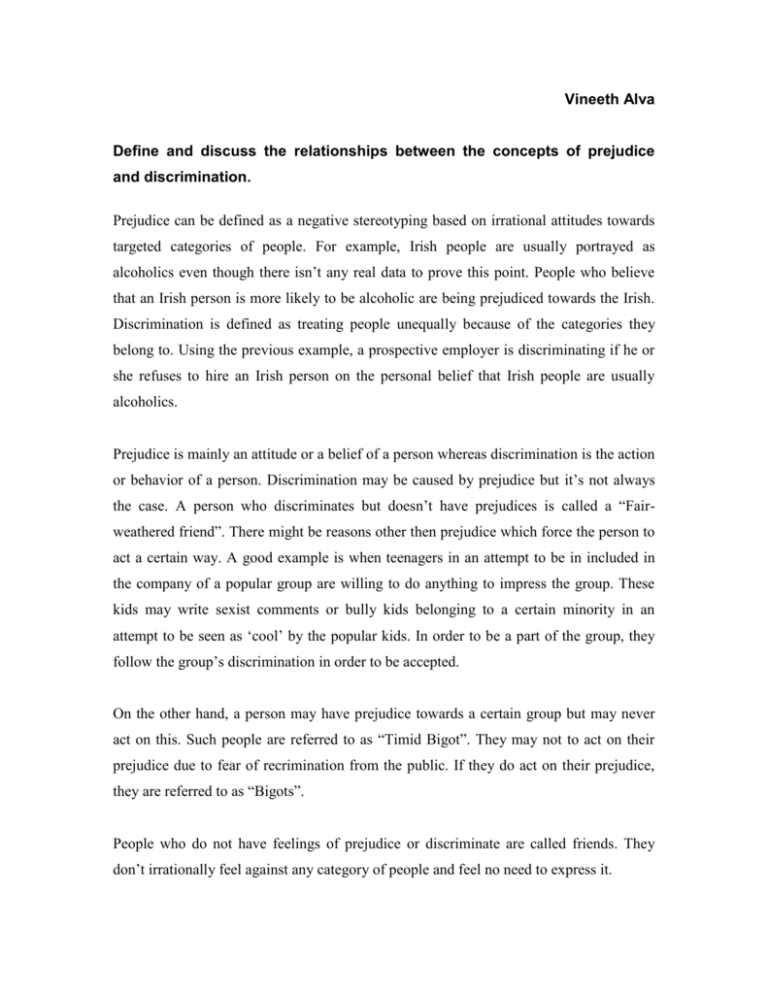
Vineeth Alva Define and discuss the relationships between the concepts of prejudice and discrimination. Prejudice can be defined as a negative stereotyping based on irrational attitudes towards targeted categories of people. For example, Irish people are usually portrayed as alcoholics even though there isn’t any real data to prove this point. People who believe that an Irish person is more likely to be alcoholic are being prejudiced towards the Irish. Discrimination is defined as treating people unequally because of the categories they belong to. Using the previous example, a prospective employer is discriminating if he or she refuses to hire an Irish person on the personal belief that Irish people are usually alcoholics. Prejudice is mainly an attitude or a belief of a person whereas discrimination is the action or behavior of a person. Discrimination may be caused by prejudice but it’s not always the case. A person who discriminates but doesn’t have prejudices is called a “Fairweathered friend”. There might be reasons other then prejudice which force the person to act a certain way. A good example is when teenagers in an attempt to be in included in the company of a popular group are willing to do anything to impress the group. These kids may write sexist comments or bully kids belonging to a certain minority in an attempt to be seen as ‘cool’ by the popular kids. In order to be a part of the group, they follow the group’s discrimination in order to be accepted. On the other hand, a person may have prejudice towards a certain group but may never act on this. Such people are referred to as “Timid Bigot”. They may not to act on their prejudice due to fear of recrimination from the public. If they do act on their prejudice, they are referred to as “Bigots”. People who do not have feelings of prejudice or discriminate are called friends. They don’t irrationally feel against any category of people and feel no need to express it. Describe and evaluate the main changes that have occurred in the American family over the last fifty years. In the last five decades, there have been a lot of changes in the world we live in. In order to adapt to these changes, the American family has significantly evolved. The most fundamental change is in the altering of gender roles. In the past, gender roles were very specific and rigid. The man was seen as the bread earner of the family and his main duty was to go to work to provide for his family. Whereas the woman was to stay at home to care for the children and cook for the family. The American family of today has drastically different gender roles. Women are no longer confined to the home and being a housewife isn’t inevitable. In order to attain a higher standard of living and to be more productive, dual income families have risen. It is very likely in modern times that both the husband and wife earn, in contrast to the family ideals of the 60’s where the family income was derived solely from the husband. This shift has resulted in women obtaining more power in their households. Household chores that were done by the housewife are now taken care of by machines, resulting in more time available. Day care centers and preschools have helped in sharing the responsibility for babies, thereby making it easier for the parents to not have to devote them as fully as they needed to. On the other hand, this results in a reduced sense of family between the children and parents. Other changes to the American family include the rise in unmarried couples, an alternative to the traditional marriage. In 1960, there were 90 married couples for every cohabitating couple and recently it has come down to approximately 10 married couple for every cohabitating couple. This ratio will drop down to 1 for every 7 married couples if the trend continues. It is expected of women to be more reluctant to take part in such a union but recent studies have shown that 1 in 3 single women choose to live with their partners before marriage, compared to 1 in 10 during the 1950’s (Colson, 1995). This might be because of increasing rate of divorces that scares adults from such commitments and increasing independence of women – both socially and economically. Many observers point that cohabitating couples have a weaker chance of lasting relative to married couples. This can be damaging to the society as breaking of relationship is followed by distress and frustration. Divorce rates have also increased sharply in American families. Studies have shown that approximately 50 percent of married couples will experience divorce. Divorces generally lead to feelings of dislike, distrust and limit the attention and love that their children seek. This increase in divorce has lead to an increase in step-parenthood. A high divorce rate and remarriage rate has lead to 20% of children living in household with one natural parent and one step parent. Families with step parents significantly altered the traditional family arrangements of fifty years into past where the concept of step parents was considered rare. Breaking up of families and including new members to replace loved ones can be distressful to all members of the family, especially children. Describe your own education giving specific examples of how the manifest functions were met for you. Identify examples of the latent functions that occurred in your community. Education is the process where society’s ideas and culture is transmitted from one generation to the next. At school, I learnt how to read and write my language. I also learnt the traditions and norms of society. We would celebrate various national holidays, which reminded us of our country’s rich history and culture. Although the primary function of school is to impart knowledge, schools play an important role in teaching the values and norm of society. This is true no matter where the schooling is done. Schooling asserted social control. Discipline, respect, responsibility and punctuality are some of the values that I learnt in school that I will hold dear for the rest of my life. School also became the backdrop for meeting with others from different backgrounds. I was exposed to students from other religions and financial situations. It was because of this exposure I learnt to become tolerant to different religions and welcome diversity. Education can also act as a change agent. Schools promote change by encouraging analytical skills and scientific skepticism. Science and mathematics encouraged a scientific way of looking at the world. Social science classes taught me about my country’s culture and rich history. Computer education was also very important in that it made sure the students were exposed to technology. Along with the manifest functions of education, there were latent functions that influenced the community. My parent’s generation was educated but for my generation, education was considered extremely important for my generation. Competition between students has been increasing and getting good grades is imperative. This increase in education has also led to a rift between generations. The younger generation has begun to question some of the age old practices and traditions.
